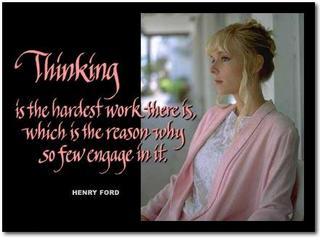








The Power of Positive Thinking
Key Point
You are what you think. You feel what you want.
Why Think Positively?
All of our feelings, beliefs and knowledge are based on our internal thoughts, both conscious and subconscious. We are in control, whether we know it or not.
We can be positive or negative, enthusiastic or dull, active or passive.
The biggest difference between people is their attitudes. For some, learning is enjoyable and exciting. For others, learning is a drudgery. For many, learning is just okay, something required on the road to a job.
"Most folks are about as happy as they make up their minds to be."
Abraham Lincoln
Our present attitudes are habits, built from the feedback of parents, friends, society and self, that form our self-image and our world image.
These attitudes are maintained by the inner conversations we constantly have with ourselves, both consciously and subconsciously.
The first step in changing our attitudes is to change our inner conversations.
What Should We Be Saying?
One approach is called the three C's: Commitment, Control and Challenge.
Commitment
Make a positive commitment to yourself, to learning, work, family, friends, nature, and other worthwhile causes. Praise yourself and others. Dream of success. Be enthusiastic.
Control
Keep your mind focused on important things. Set goals and priorities for what you think and do. Visualize to practice your actions. Develop a strategy for dealing with problems. Learn to relax. Enjoy successes. Be honest with yourself.
Challenge
Be courageous. Change and improve each day. Do your best and don't look back. See learning and change as opportunities. Try new things. Consider several options. Meet new people. Ask lots of questions. Keep track of your mental and physical health. Be optimistic.
Studies show that people with these characteristics are winners in good times and survivors in hard times.
Research shows that,
"... people who begin consciously to modify their inner conversations and assumptions report an almost immediate improvement in their performance. Their energy increases and things seem to go better ..."
Commitment, control and challenge help build self-esteem and promote positive thinking. Here are some other suggestions.
7 Suggestions for Building Positive Attitudes
In every class, look for positive people to associate with.
In every lecture, look for one more interesting idea.
In every chapter, find one more concept important to you.
With every friend, explain a new idea you've just learned.
With every teacher, ask a question.
With yourself, keep a list of your goals, positive thoughts and actions.
Remember, you are what you think, you feel what you want.
Positive thinking a pain reliever
US experts say they have strong scientific proof that mind over matter works for relieving pain.
Positive thinking was as powerful as a shot of morphine for relieving pain and reduced activity in parts of the brain that process pain information.
The Wake Forest University researchers say their findings show that by merely expecting pain to be less it will be less.
Their work is published in Proceedings of the National Academy of Sciences.
Positive thinking
Dr Robert Coghill and his team studied 10 normal, healthy volunteers who had a heat simulator applied to their legs while their brains were being scanned using functional magnetic resonance imaging (fMRI).
The heat simulator was used to produce pain and fMRI was used to map brain activity.
The brain can powerfully shape pain
Researcher Dr Robert Coghill
Before subjects underwent brain imaging, they learned to expect mild, moderate, or severe painful heat stimuli following different signals. None of the stimuli were hot enough to cause burns or damage the skin.
During brain imaging, a small percentage of the severe stimuli were incorrectly signalled as moderate stimuli to create expectations of decreased pain.
All 10 volunteers reported less pain when they expected lower levels of pain.
These expectations reduced reports of pain by more than 28% - similar to an analgesic dose of the potent painkiller morphine.
At the same time, activity in areas of the brain important to both sensory and emotional processing of pain decreased. These areas included the primary somatosensory cortex, the insular cortex and the anterior cingulate cortex.
More than just pills
Dr Coghill explained: "Pain is not solely the result of signals coming from an injured body region.
"Pain needs to be treated with more than just pills. The brain can powerfully shape pain, and we need to exploit its power."
He said the findings underscored the potential of cognitive therapy for the treatment of pain.
This study goes some way to explaining the positive impact of these psychological techniques in chronic pain states
Dr Beverly Collette, president of the British Pain Society
Dr Ed Keogh, a psychologist and pain researcher from the University of Bath, said: "For some time now we have known that psychological factors such as expectations play a role in the perception and experience of pain.
"This work is intriguing as it aims to identify specific brain regions linked to both the pain experience and expectations associated with pain.
"By empirically demonstrating such links, such research adds weight to the notion that how we think can effect what we feel. This is turn may have important implications for the way in which we prepare people for potentially painful events such as going to the dentist, childbirth or an operation."
Dr Beverly Collette, president of the British Pain Society, said: "Most people who work in pain clinics use cognitive therapy to help people manage their pain better.
"This study goes some way to explaining the positive impact of these psychological techniques in chronic pain states."
No comments:
Post a Comment